
5
NON COMPRESSION OF AIR (UNLOADED)
When air pressure in the supply reservoir reaches the
cut-out setting of the governor, the governor delivers
system air to the compressor unloader port. Air entering
the unloader port acts on the unloader piston causing
the piston to move away from its seat on the valve plate
assembly. When the unloader piston is unseated, an air
passageway is opened between the cylinder bore and a
secondary compartment — or “closed room” — in the interior
of the cylinder head.
As the piston moves from Bottom Dead Center (BDC)
to Top Dead Center (TDC) air in the cylinder bore flows
past the unseated unloader piston, into the “closed
room”. The size of the closed room is sufficient to accept
the compressed air provided by the compressor piston
without creating excessive air pressure in the “closed
room”. On the piston down stroke (TDC to BDC) air flows
in the reverse direction — from the “closed room” past the
unseated unloader piston and inlet reed valve — and into
the cylinder bore. Note: For optimum performance, it is
recommended that the air dryer installed in the system
be equipped with a “turbo cut-off” feature.
See Figure 8.
LUBRICATION
The vehicle's engine provides a continuous supply of oil
to the compressor. Pressurized oil is routed from the
engine to the compressor's oil inlet port at the rear of the
crankcase. From there the oil flows through a passageway
on the inboard side of the crankcase to the front crankshaft
journal and sleeve bearing. An oil passage in the crankshaft
routes pressurized oil to the connecting rod journal and the
rear crankshaft journal. Spray lubrication of the cylinder
bores and connecting rod wrist pin bushings is obtained as
oil is forced out around the crankshaft journals by engine
oil pressure. Oil then falls to the bottom of the compressor
crankcase and is returned to the engine through drain holes
in the compressor mounting flange.
COOLING
Bendix
®
SNA-01
™
compressors are cooled by air flowing
through the engine compartment as it passes the
compressor's crankcase bore and by the flow of engine
coolant through the cylinder head. Coolant supplied by the
engine cooling system passes through connecting lines into
the cylinder head. It passes through internal passages in
the cylinder head, cooling plate, and valve plate assembly
and returns to the engine.
Figure 9 illustrates the coolant
port locations and proper flow path.
Proper cooling is
important in minimizing discharge air temperatures - see
the tabulated technical data in the compressor specification
section of this manual for specific requirements.
AIR INDUCTION
Bendix
SNA-01 air compressors are only permitted to be
naturally aspirated — use of engine turbocharger as an air
source is not allowed.
See Figure 5 for an example of a
naturally aspirated air induction system.
PREVENTIVE MAINTENANCE
Regularly scheduled maintenance is the single most
important factor in maintaining the air brake charging
system. Refer to Table A in the Troubleshooting section
of this manual, for a guide to various considerations that
must be given to maintenance of the compressor and other
related charging system components.
Important Note: Review the warranty policy before
performing any intrusive maintenance procedures. An
extended warranty may be voided if intrusive maintenance
is performed during this period.
FIGURE 8 -
OPERATION - UNLOADED
Air From
Governor
Unloader
Port
Air above the piston shuttles back and forth
between the cylinder bore and the closed room
Unloader
Piston Up &
Unseated
Closed
Room






































